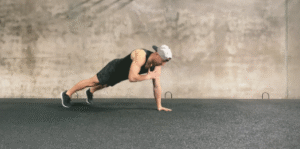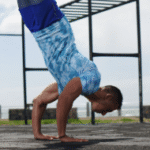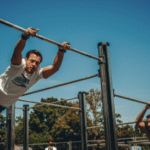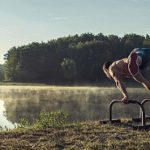Injury Prevention Strategies for Advanced Moves in Private Coaching
As a calisthenics athlete in Houston, when you transition from mastering the basics to chasing elite-level skills like the planche, human flag, or one-arm chin-up, the nature of your training changes dramatically. The loads on your joints, tendons, and ligaments increase exponentially. At this stage, injury prevention is not just a warm-up; it is a core component of your training strategy.
A private coach’s most critical role for an advanced athlete is to serve as a guide through this high-risk, high-reward territory. They implement specific, non-negotiable strategies to “bulletproof” your body, ensuring your journey to peak performance is sustainable and pain-free. This guide details the essential injury prevention strategies you will master.
The Philosophy: Building Armor Before Wielding the Sword
The core philosophy of advanced injury prevention is simple: you must build the capacity to handle the stress of a movement before you attempt the movement itself. This means your joints and connective tissues (tendons, ligaments) must be stronger and more resilient than the demands of the skill you are trying to learn. A coach ensures this by focusing on proactive “pre-habilitation” rather than reactive rehabilitation.
Strategy 1: Meticulous Joint and Tendon Conditioning
Your muscles might be strong enough, but are your tendons? This is the first area a coach will address. The wrists, elbows, and shoulders are the most vulnerable points in advanced calisthenics.
Wrist Resilience Protocol:
What it is: A dedicated routine of wrist push-ups, wrist curls (flexion and extension), and mobility drills performed in every warm-up and cool-down.
Why it’s crucial: Skills like the handstand and planche place your entire body weight on your wrists in a hyperextended position. Without specific conditioning, this leads to chronic pain and instability. A coach will ensure your wrist routine is a non-negotiable part of every session.
Elbow “Bulletproofing”:
What it is: Incorporating exercises that specifically strengthen the tendons around the elbow, which are susceptible to “golfer’s elbow” and “tennis elbow” from intense pulling and pushing. This includes slow, controlled eccentric bicep curls and tricep extensions.
Why it’s crucial: The straight-arm nature of skills like the front lever and planche puts enormous strain on the elbow joint. A coach will program these low-intensity, high-repetition conditioning movements to build tendon resilience.
Shoulder Girdle Integrity:
What it is: A focus on the small, stabilizing muscles of the rotator cuff and scapula. This involves extensive use of resistance bands for exercises like face pulls, band pull-aparts, and external/internal rotations.
Why it’s crucial: The shoulder is a highly mobile but unstable joint. Strong rotator cuffs and controlled scapular movement are what prevent impingement and keep the shoulder “packed” and safe during high-stress movements.
Strategy 2: The Art of “Never Skipping a Step” (Mastering Progressions)
The fastest way to get injured is to rush. An advanced coach is the objective voice that forces you to respect the process.
The “Good-Enough” Trap: You might be able to hold a sloppy straddle planche for one second and feel ready for the full planche. A coach will stop you.
The Coach’s Role: They will insist that you master each progression before moving to the next. This means holding a perfect-form tuck planche for a specific duration (e.g., 15-20 seconds) with complete control before you are even allowed to attempt an advanced tuck. This systematic approach ensures your body is truly ready for the increased leverage and stress of the next step.
Strategy 3: Strategic Programming and Load Management
At an advanced level, you cannot train at 100% intensity all the time. Your nervous system and connective tissues need time to recover.
Periodization: A coach will structure your training in cycles (mesocycles). You’ll have blocks focused on high-volume accumulation, followed by blocks of high-intensity strength, and, most importantly, planned deload weeks.
Deloading: This is a planned week of significantly reduced training volume and intensity. It is not “being lazy”; it is a strategic period that allows your body to supercompensate, repair tissues, and come back stronger, drastically reducing the risk of overuse injuries.
Strategy 4: The External Eye – Real-Time Form Correction
This is a benefit only private coaching can provide.
Identifying “Energy Leaks”: You might not feel the slight bend in your arm during a front lever attempt, but your coach will. This “leak” is where injuries happen. They will spot it and correct it instantly.
Preventing Compensatory Patterns: When you fatigue, your body naturally tries to cheat by using other muscles. A coach identifies these compensations (e.g., shrugging the shoulders, arching the back) and stops the set before your form breaks down to a dangerous level.
Strategy 5: Listening to the Body – Pain vs. Discomfort
A coach teaches you the most important skill of all: how to listen to your body.
Muscle Soreness (Good): The dull ache in your muscles 1-2 days after a hard workout is normal (DOMS).
Joint/Tendon Pain (Bad): A sharp, pinching, or nagging pain in or around a joint (wrist, elbow, shoulder) is a red flag. A coach will teach you to never push through this type of pain. They will immediately modify the exercise or switch to a therapeutic movement to address the issue before it becomes a chronic injury.
Conclusion:
In advanced calisthenics, your greatest strengths can expose your biggest weaknesses. Injury prevention is not an afterthought; it is the intelligent framework that makes elite performance possible. Through a meticulous process of joint conditioning, respecting progressions, strategic programming, and real-time feedback, a private coach in Houston provides the essential guidance to keep your body resilient, allowing you to safely push your limits and unlock your true strength potential.

Injury Prevention Strategies for Advanced Moves in Private Coaching
Route
Calisthenics Gym Houston Functional Bodyweight Training
Secondary phone: (346) 483-3195
Email: info@calisthenicsclubhouston.com
URL: https://calisthenicsclubhouston.com/
Monday 6:00 AM - 7:00 PM Tuesday 6:00 AM - 7:00 PM Open now Wednesday 6:00 AM - 7:00 PM Thursday 6:00 AM - 7:00 PM Friday 12:00 PM - 6:30 PM Saturday 9:45 AM - 12:00 PM Sunday 3:00 PM - 5:00 PM





